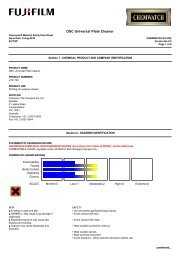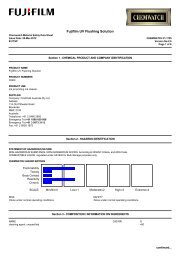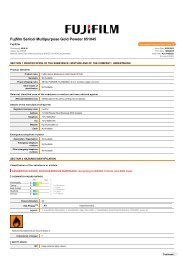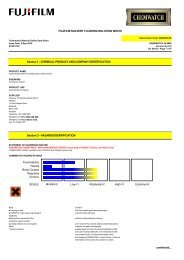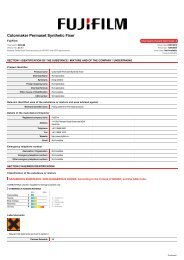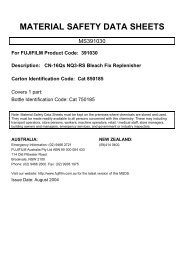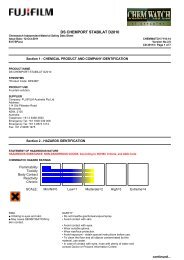Chemwatch MSDS Print - FUJIFILM Australia
Chemwatch MSDS Print - FUJIFILM Australia
Chemwatch MSDS Print - FUJIFILM Australia
Create successful ePaper yourself
Turn your PDF publications into a flip-book with our unique Google optimized e-Paper software.
Fujifilm Sericol Washup #5 857125<br />
FujiFilm <strong>Chemwatch</strong> Hazard Alert Code: 3<br />
<strong>Chemwatch</strong>: 6515-89<br />
Version No: 4.1.1.1<br />
Material Safety Data Sheet according to NOHSC and ADG requirements<br />
Issue Date: 01/01/2013<br />
<strong>Print</strong> Date: 11/07/2014<br />
Initial Date: Not Available<br />
S.Local.AUS.EN<br />
SECTION 1 IDENTIFICATION OF THE SUBSTANCE / MIXTURE AND OF THE COMPANY / UNDERTAKING<br />
Product Identifier<br />
Product name Fujifilm Sericol Washup #5 857125<br />
Chemical Name<br />
Synonyms<br />
Proper shipping name<br />
Chemical formula<br />
Other means of identification<br />
CAS number<br />
Not Applicable<br />
printing equipment cleaner solvent<br />
FLAMMABLE LIQUID, N.O.S. (contains naphtha petroleum)<br />
Not Applicable<br />
Not Available<br />
Not Applicable<br />
Relevant identified uses of the substance or mixture and uses advised against<br />
Relevant identified uses<br />
Solvent for cleaning printing equipment.<br />
Details of the manufacturer/importer<br />
Registered company name<br />
Address<br />
FujiFilm<br />
114 Old Pittwater Road Brookvale NSW<br />
<strong>Australia</strong><br />
Telephone +61 2 9466 2600<br />
Website<br />
Fax +61 2 9938 1975<br />
Email<br />
http://www.fujifilm.co<br />
Not Available<br />
Emergency telephone number<br />
Association / Organisation<br />
Emergency telephone numbers<br />
Other emergency telephone numbers<br />
Not Available<br />
Not Available<br />
Not Available<br />
SECTION 2 HAZARDS IDENTIFICATION<br />
Classification of the substance or mixture<br />
HAZARDOUS SUBSTANCE. DANGEROUS GOODS. According to the Criteria of NOHSC, and the ADG Code.<br />
CHEMWATCH HAZARD RATINGS<br />
Flammability 2<br />
Toxicity 2<br />
Body Contact 2<br />
Reactivity 1<br />
Chronic 3<br />
Min<br />
Max<br />
0 = Minimum<br />
1 = Low<br />
2 = Moderate<br />
3 = High<br />
4 = Extreme<br />
Label elements<br />
Relevant risk statements are found in section 2<br />
Poisons Schedule<br />
S5<br />
Continued...
<strong>Chemwatch</strong>: 6515-89<br />
Version No: 4.1.1.1<br />
Page 2 of 10<br />
Fujifilm Sericol Washup #5 857125<br />
Issue Date: 01/01/2013<br />
<strong>Print</strong> Date: 11/07/2014<br />
Risk Phrases [1] R65 HARMFUL-May cause lung damage if swallowed.<br />
R36/37 Irritating to eyes and respiratory system.<br />
R51/53 Toxic to aquatic organisms, may cause long-term adverse effects in the aquatic environment.<br />
R67 Vapours may cause drowsiness and dizziness.<br />
R10 Flammable.<br />
R66 Repeated exposure may cause skin dryness and cracking.<br />
R61(2) May cause harm to the unborn child.<br />
Legend:<br />
1. Classified by <strong>Chemwatch</strong>; 2. Classification drawn from HSIS ; 3. Classification drawn from EC Directive 1272/2008 - Annex VI<br />
Indication(s) of danger<br />
T, Xn, N<br />
SAFETY ADVICE<br />
S01<br />
S13<br />
S20<br />
S23<br />
S25<br />
S26<br />
S28<br />
S29<br />
S35<br />
S36<br />
S37<br />
S38<br />
S39<br />
S40<br />
S45<br />
S46<br />
S53<br />
S56<br />
S57<br />
S61<br />
S64<br />
Keep locked up.<br />
Keep away from food, drink and animal feeding stuffs.<br />
When using do not eat or drink.<br />
Do not breathe gas/fumes/vapour/spray.<br />
Avoid contact with eyes.<br />
In case of contact with eyes, rinse with plenty of water and contact Doctor or Poisons Information Centre.<br />
After contact with skin, wash immediately with plenty of water<br />
Do not empty into drains.<br />
This material and its container must be disposed of in a safe way.<br />
Wear suitable protective clothing.<br />
Wear suitable gloves.<br />
In case of insufficient ventilation, wear suitable respiratory equipment.<br />
Wear eye/face protection.<br />
To clean the floor and all objects contaminated by this material, use water and detergent.<br />
In case of accident or if you feel unwell IMMEDIATELY contact Doctor or Poisons Information Centre (show label if possible).<br />
If swallowed, seek medical advice immediately and show this container or label.<br />
Avoid exposure - obtain special instructions before use.<br />
Dispose of this material and its container at hazardous or special waste collection point.<br />
Use appropriate container to avoid environmental contamination.<br />
Avoid release to the environment. Refer to special instructions/Safety data sheets.<br />
If swallowed, rinse mouth with water (only if the person is conscious).<br />
Other hazards<br />
Inhalation, skin contact and/or ingestion may produce health damage*.<br />
Cumulative effects may result following exposure*.<br />
May produce skin discomfort*.<br />
SECTION 3 COMPOSITION / INFORMATION ON INGREDIENTS<br />
Substances<br />
See section below for composition of Mixtures<br />
Mixtures<br />
CAS No %[weight] Name<br />
108-65-6 >60 propylene glycol monomethyl ether acetate, alpha-isomer<br />
64742-95-6. 30-60 naphtha petroleum, light aromatic solvent<br />
NOTE: Manufacturer has supplied full ingredient<br />
information to allow CHEMWATCH assessment.<br />
NOTE: Manufacturer has supplied full ingredient information to allow CHEMWATCH assessment.<br />
SECTION 4 FIRST AID MEASURES<br />
Description of first aid measures<br />
Eye Contact<br />
If this product comes in contact with the eyes:<br />
Wash out immediately with fresh running water.<br />
Ensure complete irrigation of the eye by keeping eyelids apart and away from eye and moving the eyelids by occasionally lifting the upper<br />
Continued...
<strong>Chemwatch</strong>: 6515-89<br />
Version No: 4.1.1.1<br />
Page 3 of 10<br />
Fujifilm Sericol Washup #5 857125<br />
Issue Date: 01/01/2013<br />
<strong>Print</strong> Date: 11/07/2014<br />
Skin Contact<br />
Inhalation<br />
Ingestion<br />
and lower lids.<br />
Seek medical attention without delay; if pain persists or recurs seek medical attention.<br />
Removal of contact lenses after an eye injury should only be undertaken by skilled personnel.<br />
If skin contact occurs:<br />
Immediately remove all contaminated clothing, including footwear.<br />
Flush skin and hair with running water (and soap if available).<br />
Seek medical attention in event of irritation.<br />
If fumes or combustion products are inhaled remove from contaminated area.<br />
Lay patient down. Keep warm and rested.<br />
Prostheses such as false teeth, which may block airway, should be removed, where possible, prior to initiating first aid procedures.<br />
Apply artificial respiration if not breathing, preferably with a demand valve resuscitator, bag-valve mask device, or pocket mask as trained.<br />
Perform CPR if necessary.<br />
Transport to hospital, or doctor, without delay.<br />
If swallowed do NOT induce vomiting.<br />
If vomiting occurs, lean patient forward or place on left side (head-down position, if possible) to maintain open airway and prevent<br />
aspiration.<br />
Observe the patient carefully.<br />
Never give liquid to a person showing signs of being sleepy or with reduced awareness; i.e. becoming unconscious.<br />
Give water to rinse out mouth, then provide liquid slowly and as much as casualty can comfortably drink.<br />
Seek medical advice.<br />
Avoid giving milk or oils.<br />
Avoid giving alcohol.<br />
Indication of any immediate medical attention and special treatment needed<br />
Any material aspirated during vomiting may produce lung injury. Therefore emesis should not be induced mechanically or pharmacologically.<br />
Mechanical means should be used if it is considered necessary to evacuate the stomach contents; these include gastric lavage after<br />
endotracheal intubation. If spontaneous vomiting has occurred after ingestion, the patient should be monitored for difficult breathing, as adverse<br />
effects of aspiration into the lungs may be delayed up to 48 hours.<br />
For acute or short term repeated exposures to petroleum distillates or related hydrocarbons:<br />
Primary threat to life, from pure petroleum distillate ingestion and/or inhalation, is respiratory failure.<br />
Patients should be quickly evaluated for signs of respiratory distress (e.g. cyanosis, tachypnoea, intercostal retraction, obtundation) and<br />
given oxygen. Patients with inadequate tidal volumes or poor arterial blood gases (pO2 50 mm Hg) should be intubated.<br />
Arrhythmias complicate some hydrocarbon ingestion and/or inhalation and electrocardiographic evidence of myocardial injury has been<br />
reported; intravenous lines and cardiac monitors should be established in obviously symptomatic patients. The lungs excrete inhaled<br />
solvents, so that hyperventilation improves clearance.<br />
A chest x-ray should be taken immediately after stabilisation of breathing and circulation to document aspiration and detect the presence of<br />
pneumothorax.<br />
Epinephrine (adrenalin) is not recommended for treatment of bronchospasm because of potential myocardial sensitisation to<br />
catecholamines. Inhaled cardioselective bronchodilators (e.g. Alupent, Salbutamol) are the preferred agents, with aminophylline a second<br />
choice.<br />
Lavage is indicated in patients who require decontamination; ensure use of cuffed endotracheal tube in adult patients. [Ellenhorn and<br />
Barceloux: Medical Toxicology]<br />
for simple esters:<br />
--------------------------------------------------------------<br />
BASIC TREATMENT<br />
--------------------------------------------------------------<br />
Establish a patent airway with suction where necessary.<br />
Watch for signs of respiratory insufficiency and assist ventilation as necessary.<br />
Administer oxygen by non-rebreather mask at 10 to 15 l/min.<br />
Monitor and treat, where necessary, for pulmonary oedema .<br />
Monitor and treat, where necessary, for shock.<br />
DO NOT use emetics. Where ingestion is suspected rinse mouth and give up to 200 ml water (5 ml/kg recommended) for dilution where<br />
patient is able to swallow, has a strong gag reflex and does not drool.<br />
Give activated charcoal.<br />
--------------------------------------------------------------<br />
ADVANCED TREATMENT<br />
--------------------------------------------------------------<br />
Consider orotracheal or nasotracheal intubation for airway control in unconscious patient or where respiratory arrest has occurred.<br />
Positive-pressure ventilation using a bag-valve mask might be of use.<br />
Monitor and treat, where necessary, for arrhythmias.<br />
Start an IV D5W TKO. If signs of hypovolaemia are present use lactated Ringers solution. Fluid overload might create complications.<br />
Drug therapy should be considered for pulmonary oedema.<br />
Hypotension with signs of hypovolaemia requires the cautious administration of fluids. Fluid overload might create complications.<br />
Treat seizures with diazepam.<br />
Proparacaine hydrochloride should be used to assist eye irrigation.<br />
--------------------------------------------------------------<br />
EMERGENCY DEPARTMENT<br />
--------------------------------------------------------------<br />
Laboratory analysis of complete blood count, serum electrolytes, BUN, creatinine, glucose, urinalysis, baseline for serum<br />
aminotransferases (ALT and AST), calcium, phosphorus and magnesium, may assist in establishing a treatment regime. Other useful<br />
analyses include anion and osmolar gaps, arterial blood gases (ABGs), chest radiographs and electrocardiograph.<br />
Positive end-expiratory pressure (PEEP)-assisted ventilation may be required for acute parenchymal injury or adult respiratory distress<br />
syndrome.<br />
Consult a toxicologist as necessary.<br />
BRONSTEIN, A.C. and CURRANCE, P.L. EMERGENCY CARE FOR HAZARDOUS MATERIALS EXPOSURE: 2nd Ed. 1994<br />
SECTION 5 FIREFIGHTING MEASURES<br />
Continued...
<strong>Chemwatch</strong>: 6515-89<br />
Version No: 4.1.1.1<br />
Page 4 of 10<br />
Fujifilm Sericol Washup #5 857125<br />
Issue Date: 01/01/2013<br />
<strong>Print</strong> Date: 11/07/2014<br />
Extinguishing media<br />
Alcohol stable foam.<br />
Dry chemical powder.<br />
BCF (where regulations permit).<br />
Carbon dioxide.<br />
Special hazards arising from the substrate or mixture<br />
Fire Incompatibility<br />
Avoid contamination with oxidising agents i.e. nitrates, oxidising acids, chlorine bleaches, pool chlorine etc. as ignition may result<br />
Advice for firefighters<br />
Fire Fighting<br />
Fire/Explosion Hazard<br />
Alert Fire Brigade and tell them location and nature of hazard.<br />
May be violently or explosively reactive.<br />
Wear breathing apparatus plus protective gloves.<br />
Prevent, by any means available, spillage from entering drains or water course.<br />
Liquid and vapour are flammable.<br />
Moderate fire hazard when exposed to heat or flame.<br />
Vapour forms an explosive mixture with air.<br />
Moderate explosion hazard when exposed to heat or flame.<br />
SECTION 6 ACCIDENTAL RELEASE MEASURES<br />
Personal precautions, protective equipment and emergency procedures<br />
Minor Spills<br />
Major Spills<br />
Remove all ignition sources.<br />
Clean up all spills immediately.<br />
Avoid breathing vapours and contact with skin and eyes.<br />
Control personal contact with the substance, by using protective equipment.<br />
Clear area of personnel and move upwind.<br />
Alert Fire Brigade and tell them location and nature of hazard.<br />
May be violently or explosively reactive.<br />
Wear breathing apparatus plus protective gloves.<br />
Personal Protective Equipment advice is contained in Section 8 of the <strong>MSDS</strong>.<br />
SECTION 7 HANDLING AND STORAGE<br />
Precautions for safe handling<br />
Safe handling<br />
Other information<br />
Containers, even those that have been emptied, may contain explosive vapours.<br />
Do NOT cut, drill, grind, weld or perform similar operations on or near containers.<br />
DO NOT allow clothing wet with material to stay in contact with skin<br />
Electrostatic discharge may be generated during pumping - this may result in fire.<br />
Ensure electrical continuity by bonding and grounding (earthing) all equipment.<br />
Store in original containers in approved flammable liquid storage area.<br />
Store away from incompatible materials in a cool, dry, well-ventilated area.<br />
DO NOT store in pits, depressions, basements or areas where vapours may be trapped.<br />
No smoking, naked lights, heat or ignition sources.<br />
Conditions for safe storage, including any incompatibilities<br />
Suitable container<br />
Storage incompatibility<br />
Packing as supplied by manufacturer.<br />
Plastic containers may only be used if approved for flammable liquid.<br />
Check that containers are clearly labelled and free from leaks.<br />
For low viscosity materials (i) : Drums and jerry cans must be of the non-removable head type.<br />
Avoid reaction with oxidising agents<br />
PACKAGE MATERIAL INCOMPATIBILITIES<br />
Not Available<br />
SECTION 8 EXPOSURE CONTROLS / PERSONAL PROTECTION<br />
Control parameters<br />
OCCUPATIONAL EXPOSURE LIMITS (OEL)<br />
INGREDIENT DATA<br />
Source Ingredient Material name TWA STEL Peak Notes<br />
<strong>Australia</strong> Exposure Standards<br />
propylene glycol monomethyl ether acetate,<br />
alpha-isomer<br />
1-Methoxy-2-propanol<br />
acetate<br />
274 mg/m3 / 50<br />
ppm<br />
548 mg/m3 / 100<br />
ppm<br />
Not<br />
Available<br />
Sk<br />
EMERGENCY LIMITS<br />
Ingredient TEEL-0 TEEL-1 TEEL-2 TEEL-3<br />
Continued...
<strong>Chemwatch</strong>: 6515-89<br />
Version No: 4.1.1.1<br />
Page 5 of 10<br />
Fujifilm Sericol Washup #5 857125<br />
Issue Date: 01/01/2013<br />
<strong>Print</strong> Date: 11/07/2014<br />
propylene glycol monomethyl ether acetate,<br />
alpha-isomer<br />
50 ppm 150 ppm 250 ppm 600 ppm<br />
naphtha petroleum, light aromatic solvent 500 ppm 750 ppm 750 ppm 750 ppm<br />
Ingredient Original IDLH Revised IDLH<br />
propylene glycol monomethyl ether acetate,<br />
alpha-isomer<br />
Not Available<br />
Not Available<br />
naphtha petroleum, light aromatic solvent Not Available Not Available<br />
Exposure controls<br />
Appropriate engineering controls<br />
Engineering controls are used to remove a hazard or place a barrier between the worker and the hazard. Well-designed engineering controls<br />
can be highly effective in protecting workers and will typically be independent of worker interactions to provide this high level of protection.<br />
The basic types of engineering controls are:<br />
Process controls which involve changing the way a job activity or process is done to reduce the risk.<br />
Enclosure and/or isolation of emission source which keeps a selected hazard "physically" away from the worker and ventilation that strategically<br />
"adds" and "removes" air in the work environment.<br />
Personal protection<br />
Eye and face protection<br />
Skin protection<br />
Hands/feet protection<br />
Body protection<br />
Other protection<br />
Thermal hazards<br />
Safety glasses with side shields.<br />
Chemical goggles.<br />
Contact lenses may pose a special hazard; soft contact lenses may absorb and concentrate irritants. A written policy document, describing<br />
the wearing of lenses or restrictions on use, should be created for each workplace or task.<br />
See Hand protection below<br />
Wear chemical protective gloves, e.g. PVC.<br />
Wear safety footwear or safety gumboots, e.g. Rubber<br />
For esters:<br />
Do NOT use natural rubber, butyl rubber, EPDM or polystyrene-containing materials.<br />
The selection of suitable gloves does not only depend on the material, but also on further marks of quality which vary from manufacturer to<br />
manufacturer. Where the chemical is a preparation of several substances, the resistance of the glove material can not be calculated in advance<br />
and has therefore to be checked prior to the application.<br />
See Other protection below<br />
Overalls.<br />
PVC Apron.<br />
PVC protective suit may be required if exposure severe.<br />
Eyewash unit.<br />
Not Available<br />
Recommended material(s)<br />
GLOVE SELECTION INDEX<br />
Glove selection is based on a modified presentation of the:<br />
"Forsberg Clothing Performance Index".<br />
The effect(s) of the following substance(s) are taken into account in the computergenerated<br />
selection:<br />
Fujifilm Sericol Washup #5 857125 Not Available<br />
Material<br />
* CPI - <strong>Chemwatch</strong> Performance Index<br />
A: Best Selection<br />
B: Satisfactory; may degrade after 4 hours continuous immersion<br />
C: Poor to Dangerous Choice for other than short term immersion<br />
NOTE: As a series of factors will influence the actual performance of the glove, a final<br />
selection must be based on detailed observation. -<br />
* Where the glove is to be used on a short term, casual or infrequent basis, factors such as<br />
"feel" or convenience (e.g. disposability), may dictate a choice of gloves which might otherwise<br />
be unsuitable following long-term or frequent use. A qualified practitioner should be consulted.<br />
CPI<br />
Respiratory protection<br />
Type A Filter of sufficient capacity. (AS/NZS 1716 & 1715, EN 143:2000 & 149:2001, ANSI Z88<br />
or national equivalent)<br />
Where the concentration of gas/particulates in the breathing zone,<br />
approaches or exceeds the "Exposure Standard" (or ES), respiratory<br />
protection is required.<br />
Degree of protection varies with both face-piece and Class of filter;<br />
the nature of protection varies with Type of filter.<br />
Required<br />
Minimum<br />
Protection<br />
Factor<br />
up to 10 x ES<br />
Half-Face<br />
Respirator<br />
A-AUS / Class<br />
1<br />
Full-Face<br />
Respirator<br />
up to 50 x ES Air-line* - -<br />
up to 100 x ES - A-3 -<br />
100+ x ES - Air-line** -<br />
-<br />
Powered Air<br />
Respirator<br />
A-PAPR-AUS /<br />
Class 1<br />
* - Continuous-flow; ** - Continuous-flow or positive pressure<br />
demand<br />
A(All classes) = Organic vapours, B AUS or B1 = Acid gasses, B2 =<br />
Acid gas or hydrogen cyanide(HCN), B3 = Acid gas or hydrogen<br />
cyanide(HCN), E = Sulfur dioxide(SO2), G = Agricultural chemicals,<br />
K = Ammonia(NH3), Hg = Mercury, NO = Oxides of nitrogen, MB =<br />
Methyl bromide, AX = Low boiling point organic compounds(below<br />
65 degC)<br />
Continued...
<strong>Chemwatch</strong>: 6515-89<br />
Version No: 4.1.1.1<br />
Page 6 of 10<br />
Fujifilm Sericol Washup #5 857125<br />
Issue Date: 01/01/2013<br />
<strong>Print</strong> Date: 11/07/2014<br />
SECTION 9 PHYSICAL AND CHEMICAL PROPERTIES<br />
Information on basic physical and chemical properties<br />
Appearance<br />
Note that all of the monopropylene glycol ethers may exist in two isomeric forms, alpha or beta. The alpha form, which is thermodynamically<br />
favored during synthesis, consists of a secondary alcohol configuration. The beta form consists of a primary alcohol. The two isomeric forms are<br />
shown above.<br />
Physical state Liquid Relative density (Water = 1) 0.92<br />
Odour Not Available Partition coefficient n-octanol / water Not Available<br />
Odour threshold Not Available Auto-ignition temperature (°C) Not Available<br />
pH (as supplied) Not Applicable Decomposition temperature Not Available<br />
Melting point / freezing point (°C) Not Available Viscosity (cSt) Not Available<br />
Initial boiling point and boiling range<br />
(°C)<br />
145 Molecular weight (g/mol) Not Applicable<br />
Flash point (°C) 48 Taste Not Available<br />
Evaporation rate Not Available Explosive properties Not Available<br />
Flammability Flammable. Oxidising properties Not Available<br />
Upper Explosive Limit (%) 7.0 (PGMA) Surface Tension (dyn/cm or mN/m) Not Available<br />
Lower Explosive Limit (%) 1.5 (PGMA) Volatile Component (%vol) Not Available<br />
Vapour pressure (kPa) Not Available Gas group Not Available<br />
Solubility in water (g/L) Immiscible pH as a solution(1%) Not Applicable<br />
Vapour density (Air = 1) >1 VOC g/L Not Available<br />
SECTION 10 STABILITY AND REACTIVITY<br />
Reactivity See section 7<br />
Chemical stability<br />
Unstable in the presence of incompatible materials.<br />
Product is considered stable.<br />
Hazardous polymerisation will not occur.<br />
Possibility of hazardous reactions See section 7<br />
Conditions to avoid See section 7<br />
Incompatible materials See section 7<br />
Hazardous decomposition products See section 5<br />
SECTION 11 TOXICOLOGICAL INFORMATION<br />
Information on toxicological effects<br />
Inhaled<br />
Ingestion<br />
Evidence shows, or practical experience predicts, that the material produces irritation of the respiratory system, in a substantial number of<br />
individuals, following inhalation. In contrast to most organs, the lung is able to respond to a chemical insult by first removing or neutralising the<br />
irritant and then repairing the damage. The repair process, which initially evolved to protect mammalian lungs from foreign matter and antigens,<br />
may however, produce further lung damage resulting in the impairment of gas exchange, the primary function of the lungs. Respiratory tract<br />
irritation often results in an inflammatory response involving the recruitment and activation of many cell types, mainly derived from the vascular<br />
system.<br />
Swallowing of the liquid may cause aspiration of vomit into the lungs with the risk of haemorrhaging, pulmonary oedema, progressing to chemical<br />
pneumonitis; serious consequences may result.<br />
Signs and symptoms of chemical (aspiration) pneumonitis may include coughing, gasping, choking, burning of the mouth, difficult breathing, and<br />
bluish coloured skin (cyanosis).<br />
Accidental ingestion of the material may be damaging to the health of the individual.<br />
Ingestion of petroleum hydrocarbons may produce irritation of the pharynx, oesophagus, stomach and small intestine with oedema and mucosal<br />
ulceration resulting; symptoms include a burning sensation in the mouth and throat.<br />
Skin Contact<br />
Eye<br />
Evidence exists, or practical experience predicts, that the material either produces inflammation of the skin in a substantial number of individuals<br />
following direct contact, and/or produces significant inflammation when applied to the healthy intact skin of animals, for up to four hours, such<br />
inflammation being present twenty-four hours or more after the end of the exposure period. Skin irritation may also be present after prolonged or<br />
repeated exposure; this may result in a form of contact dermatitis (nonallergic). The dermatitis is often characterised by skin redness (erythema)<br />
and swelling (oedema) which may progress to blistering (vesiculation), scaling and thickening of the epidermis. At the microscopic level there<br />
may be intercellular oedema of the spongy layer of the skin (spongiosis) and intracellular oedema of the epidermis.<br />
Evidence exists, or practical experience predicts, that the material may cause eye irritation in a substantial number of individuals and/or may<br />
produce significant ocular lesions which are present twenty-four hours or more after instillation into the eye(s) of experimental animals.<br />
Repeated or prolonged eye contact may cause inflammation characterised by temporary redness (similar to windburn) of the conjunctiva<br />
(conjunctivitis); temporary impairment of vision and/or other transient eye damage/ulceration may occur.<br />
Petroleum hydrocarbons may produce pain after direct contact with the eyes. Slight, but transient disturbances of the corneal epithelium may also<br />
result.<br />
Continued...
<strong>Chemwatch</strong>: 6515-89<br />
Version No: 4.1.1.1<br />
Page 7 of 10<br />
Fujifilm Sericol Washup #5 857125<br />
Issue Date: 01/01/2013<br />
<strong>Print</strong> Date: 11/07/2014<br />
Chronic<br />
Long-term exposure to respiratory irritants may result in disease of the airways involving difficult breathing and related systemic problems.<br />
There is sufficient evidence to provide a strong presumption that human exposure to the material may result in developmental toxicity, generally on<br />
the basis of:<br />
- clear results in appropriate animal studies where effects have been observed in the absence of marked maternal toxicity, or at around the same<br />
dose levels as other toxic effects but which are not secondary non-specific consequences of the other toxic effects.<br />
Limited evidence suggests that repeated or long-term occupational exposure may produce cumulative health effects involving organs or<br />
biochemical systems.<br />
Repeated exposure to higher concentrations of propylene glycol monomethyl ether acetate (PGMEA) (1000 ppm and above) causes mild liver and<br />
kidney damage in animals.<br />
Fujifilm Sericol Washup #5 857125<br />
TOXICITY<br />
Not Available<br />
IRRITATION<br />
Not Available<br />
propylene glycol monomethyl ether<br />
acetate, alpha-isomer<br />
TOXICITY<br />
Dermal (rabbit) LD50: >5000 mg/kg*<br />
Inhalation (rat) LC50: 4345 ppm/6h<br />
Oral (rat) LD50: 8532 mg/kg<br />
Not Available<br />
IRRITATION<br />
* [CCINFO]<br />
Nil reported<br />
Not Available<br />
naphtha petroleum, light aromatic<br />
solvent<br />
TOXICITY<br />
Inhalation (rat) LC50: >3670 ppm/8 h *<br />
Oral (rat) LD50: >5000 mg/kg *<br />
Not Available<br />
IRRITATION<br />
Nil reported<br />
Not Available<br />
* Value obtained from manufacturer's msds<br />
unless otherwise specified data extracted from RTECS - Register of Toxic Effects of Chemical Substances<br />
Fujifilm Sericol Washup #5 857125<br />
Asthma-like symptoms may continue for months or even years after exposure to the material ceases. This may be due to a non-allergenic<br />
condition known as reactive airways dysfunction syndrome (RADS) which can occur following exposure to high levels of highly irritating<br />
compound. Key criteria for the diagnosis of RADS include the absence of preceding respiratory disease, in a non-atopic individual, with<br />
abrupt onset of persistent asthma-like symptoms within minutes to hours of a documented exposure to the irritant. A reversible airflow pattern,<br />
on spirometry, with the presence of moderate to severe bronchial hyperreactivity on methacholine challenge testing and the lack of minimal<br />
lymphocytic inflammation, without eosinophilia, have also been included in the criteria for diagnosis of RADS.<br />
PROPYLENE GLYCOL MONOMETHYL<br />
ETHER ACETATE, ALPHA-ISOMER<br />
for propylene glycol ethers (PGEs):<br />
Typical propylene glycol ethers include propylene glycol n-butyl ether (PnB); dipropylene glycol n-butyl ether (DPnB); dipropylene glycol<br />
methyl ether acetate (DPMA); tripropylene glycol methyl ether (TPM).<br />
Testing of a wide variety of propylene glycol ethers Testing of a wide variety of propylene glycol ethers has shown that propylene glycol-based<br />
ethers are less toxic than some ethers of the ethylene series. The common toxicities associated with the lower molecular weight homologues<br />
of the ethylene series, such as adverse effects on reproductive organs, the developing embryo and fetus, blood (haemolytic effects), or<br />
thymus, are not seen with the commercial-grade propylene glycol ethers. In the ethylene series, metabolism of the terminal hydroxyl group<br />
produces an alkoxyacetic acid.<br />
A BASF report (in ECETOC ) showed that inhalation exposure to 545 ppm PGMEA (beta isomer) was associated with a teratogenic<br />
response in rabbits; but exposure to 145 ppm and 36 ppm had no adverse effects. The beta isomer of PGMEA comprises only 10% of the<br />
commercial material, the remaining 90% is alpha isomer. Hazard appears low but emphasizes the need for care in handling this chemical.<br />
[I.C.I]<br />
NAPHTHA PETROLEUM, LIGHT<br />
AROMATIC SOLVENT<br />
For trimethylbenzenes:<br />
Absorption of 1,2,4-trimethylbenzene occurs after oral, inhalation, or dermal exposure. Occupationally, inhalation and dermal exposures are<br />
the most important routes of absorption although systemic intoxication from dermal absorption is not likely to occur due to the dermal irritation<br />
caused by the chemical prompting quick removal. Following oral administration of the chemical to rats, 62.6% of the dose was recovered as<br />
urinary metabolites indicating substantial absorption . 1,2,4-Trimethylbenzene is lipophilic and may accumulate in fat and fatty tissues.<br />
Inhalation (rat) TCLo: 1320 ppm/6h/90D-I * [Devoe]<br />
Acute Toxicity<br />
Skin Irritation/Corrosion<br />
Serious Eye Damage/Irritation<br />
Respiratory or Skin sensitisation<br />
Mutagenicity<br />
Carcinogenicity<br />
Reproductivity<br />
STOT - Single Exposure<br />
STOT - Repeated Exposure<br />
Aspiration Hazard<br />
Legend: – Data required to make classification available<br />
– Data available but does not fill the criteria for classification<br />
– Data Not Available to make classification<br />
CMR STATUS<br />
SKIN propylene glycol monomethyl ether acetate, alpha-isomer <strong>Australia</strong> Exposure Standards - Skin Sk<br />
Continued...
<strong>Chemwatch</strong>: 6515-89<br />
Version No: 4.1.1.1<br />
Page 8 of 10<br />
Fujifilm Sericol Washup #5 857125<br />
Issue Date: 01/01/2013<br />
<strong>Print</strong> Date: 11/07/2014<br />
SECTION 12 ECOLOGICAL INFORMATION<br />
Toxicity<br />
Toxic to aquatic organisms, may cause long-term adverse effects in the aquatic environment.<br />
Do NOT allow product to come in contact with surface waters or to intertidal areas below the mean high water mark. Do not contaminate water when cleaning equipment or disposing of equipment<br />
wash-waters.<br />
Wastes resulting from use of the product must be disposed of on site or at approved waste sites.<br />
Persistence and degradability<br />
Ingredient Persistence: Water/Soil Persistence: Air<br />
Not Available Not Available Not Available<br />
Bioaccumulative potential<br />
Ingredient<br />
Not Available<br />
Bioaccumulation<br />
Not Available<br />
Mobility in soil<br />
Ingredient<br />
Not Available<br />
Mobility<br />
Not Available<br />
SECTION 13 DISPOSAL CONSIDERATIONS<br />
Waste treatment methods<br />
Product / Packaging disposal<br />
Containers may still present a chemical hazard/ danger when empty.<br />
Return to supplier for reuse/ recycling if possible.<br />
Otherwise:<br />
If container can not be cleaned sufficiently well to ensure that residuals do not remain or if the container cannot be used to store the same<br />
product, then puncture containers, to prevent re-use, and bury at an authorised landfill.<br />
Where possible retain label warnings and <strong>MSDS</strong> and observe all notices pertaining to the product.<br />
SECTION 14 TRANSPORT INFORMATION<br />
Labels Required<br />
Marine Pollutant<br />
HAZCHEM<br />
•3Y<br />
Land transport (ADG)<br />
UN number 1993<br />
Packing group<br />
UN proper shipping name<br />
Environmental hazard<br />
Transport hazard class(es)<br />
III<br />
FLAMMABLE LIQUID, N.O.S. (contains naphtha petroleum)<br />
No relevant data<br />
Class 3<br />
Subrisk Not Applicable<br />
Special precautions for user<br />
Special provisions 223 274<br />
Limited quantity<br />
5 L<br />
Air transport (ICAO-IATA / DGR)<br />
UN number 1993<br />
Packing group<br />
UN proper shipping name<br />
Environmental hazard<br />
III<br />
Flammable liquid, n.o.s. * (contains naphtha petroleum)<br />
No relevant data<br />
Continued...
<strong>Chemwatch</strong>: 6515-89<br />
Version No: 4.1.1.1<br />
Page 9 of 10<br />
Fujifilm Sericol Washup #5 857125<br />
Issue Date: 01/01/2013<br />
<strong>Print</strong> Date: 11/07/2014<br />
ICAO/IATA Class 3<br />
Transport hazard class(es)<br />
ICAO / IATA Subrisk<br />
ERG Code<br />
Not Applicable<br />
3L<br />
Special precautions for user<br />
Special provisions<br />
A3<br />
Cargo Only Packing Instructions 366<br />
Cargo Only Maximum Qty / Pack<br />
220 L<br />
Passenger and Cargo Packing Instructions 355<br />
Passenger and Cargo Maximum Qty / Pack<br />
60 L<br />
Passenger and Cargo Limited Quantity Packing Instructions Y344<br />
Passenger and Cargo Limited Maximum Qty / Pack<br />
10 L<br />
Sea transport (IMDG-Code / GGVSee)<br />
UN number 1993<br />
Packing group<br />
UN proper shipping name<br />
Environmental hazard<br />
Transport hazard class(es)<br />
III<br />
FLAMMABLE LIQUID, N.O.S. (contains naphtha petroleum)<br />
No relevant data<br />
IMDG Class 3<br />
IMDG Subrisk Not Applicable<br />
Special precautions for user<br />
EMS Number F-E , S-E<br />
Special provisions 223 274 955<br />
Limited Quantities 5 L<br />
Transport in bulk according to Annex II of MARPOL 73 / 78 and the IBC code<br />
Source Ingredient Pollution Category<br />
IMO MARPOL 73/78 (Annex II) - List of<br />
Noxious Liquid Substances Carried in Bulk<br />
propylene glycol monomethyl ether acetate, alpha-isomer<br />
Z<br />
SECTION 15 REGULATORY INFORMATION<br />
Safety, health and environmental regulations / legislation specific for the substance or mixture<br />
propylene glycol monomethyl ether<br />
acetate, alpha-isomer(108-65-6) is found<br />
on the following regulatory lists<br />
naphtha petroleum, light aromatic<br />
solvent(64742-95-6.) is found on the<br />
following regulatory lists<br />
"International Council of Chemical Associations (ICCA) - High Production Volume List","IOFI Global Reference List of Chemically Defined<br />
Substances","IMO MARPOL 73/78 (Annex II) - List of Noxious Liquid Substances Carried in Bulk","International Maritime Dangerous Goods<br />
Requirements (IMDG Code)","International Maritime Dangerous Goods Requirements (IMDG Code) - Substance Index","<strong>Australia</strong> Exposure<br />
Standards","<strong>Australia</strong> Approved Active Constituents for Agricultural Chemical Products","IMO Provisional Categorization of Liquid Substances<br />
- List 3: (Trade-named) mixtures containing at least 99% by weight of components already assessed by IMO, presenting safety<br />
hazards","FisherTransport Information","IMO MARPOL 73/78 (Annex II) - List of Other Liquid Substances","<strong>Australia</strong> Dangerous Goods Code<br />
(ADG Code) - List of Emergency Action Codes","United Nations Recommendations on the Transport of Dangerous Goods Model Regulations<br />
(English)","OECD List of High Production Volume (HPV) Chemicals","<strong>Australia</strong> Standard for the Uniform Scheduling of Medicines and<br />
Poisons (SUSMP) - Appendix B (Part 3)","OSPAR National List of Candidates for Substitution – Norway","<strong>Australia</strong> Inventory of Chemical<br />
Substances (AICS)","Belgium Federal Public Service Mobility and Transport, Regulations concerning the International Carriage of Dangerous<br />
Goods by Rail - Table A: Dangerous Goods List - RID 2013 (Dutch)","International Numbering System for Food Additives","IMO IBC Code<br />
Chapter 18: List of products to which the Code does not apply","<strong>Australia</strong> National Pollutant Inventory","OECD Existing Chemicals<br />
Database","Sigma-AldrichTransport Information","<strong>Australia</strong> High Volume Industrial Chemical List (HVICL)","<strong>Australia</strong> <strong>Australia</strong>n Pesticides<br />
and Veterinary Medicines Authority (APVM) Record of approved active constituents","United Nations Recommendations on the Transport of<br />
Dangerous Goods Model Regulations (Spanish)","<strong>Australia</strong> Dangerous Goods Code (ADG Code) - Dangerous Goods List","GESAMP/EHS<br />
Composite List - GESAMP Hazard Profiles","International Air Transport Association (IATA) Dangerous Goods Regulations","<strong>Australia</strong><br />
Hazardous Substances Information System - Consolidated Lists","International Fragrance Association (IFRA) Survey: Transparency List","IMO<br />
IBC Code Chapter 17: Summary of minimum requirements"<br />
"International Council of Chemical Associations (ICCA) - High Production Volume List","International Maritime Dangerous Goods<br />
Requirements (IMDG Code)","IMO MARPOL 73/78 (Annex II) - List of Noxious Liquid Substances Carried in Bulk","<strong>Australia</strong> - New South<br />
Wales Protection of the Environment Operations (Waste) Regulation 2005 - Waste transported within NSW or interstate and required to be<br />
tracked","International Maritime Dangerous Goods Requirements (IMDG Code) - Substance Index","<strong>Australia</strong> Exposure Standards","<strong>Australia</strong> -<br />
Tasmania - Work Health and Safety Regulations 2012 - Restricted hazardous chemicals","<strong>Australia</strong> - Northern Territories Work Health and<br />
Safety National Uniform Legislation Regulations- Restricted hazardous chemicals","IMO Provisional Categorization of Liquid Substances - List<br />
2: Pollutant only mixtures containing at least 99% by weight of components already assessed by IMO","<strong>Australia</strong> Dangerous Goods Code (ADG<br />
Code) - List of Emergency Action Codes","United Nations Recommendations on the Transport of Dangerous Goods Model Regulations<br />
(English)","OECD List of High Production Volume (HPV) Chemicals","<strong>Australia</strong> - South <strong>Australia</strong> - Work Health and Safety Regulations 2012 -<br />
Restricted hazardous chemicals","<strong>Australia</strong> - Queensland Work Health and Safety Regulation - Restricted hazardous chemicals","International<br />
Agency for Research on Cancer (IARC) - Agents Classified by the IARC Monographs","<strong>Australia</strong> Inventory of Chemical Substances<br />
(AICS)","Belgium Federal Public Service Mobility and Transport, Regulations concerning the International Carriage of Dangerous Goods by<br />
Rail - Table A: Dangerous Goods List - RID 2013 (Dutch)","International Chemical Secretariat (ChemSec) SIN List (*Substitute It<br />
Now!)","International Society of Automotive Engineers (SAE) Declarable Substances Chemical List - ARP9536","<strong>Australia</strong> - New South Wales -<br />
Work Health and Safety Regulation 2011 Restricted hazardous chemicals","<strong>Australia</strong> National Pollutant Inventory","OECD Existing Chemicals<br />
Database","<strong>Australia</strong> High Volume Industrial Chemical List (HVICL)","United Nations Recommendations on the Transport of Dangerous Goods<br />
Model Regulations (Spanish)","<strong>Australia</strong> Dangerous Goods Code (ADG Code) - Dangerous Goods List","International Air Transport<br />
Continued...
<strong>Chemwatch</strong>: 6515-89<br />
Version No: 4.1.1.1<br />
Page 10 of 10<br />
Fujifilm Sericol Washup #5 857125<br />
Issue Date: 01/01/2013<br />
<strong>Print</strong> Date: 11/07/2014<br />
Association (IATA) Dangerous Goods Regulations","<strong>Australia</strong> Hazardous Substances Information System - Consolidated Lists","<strong>Australia</strong> Work<br />
Health and Safety Regulations 2011 - Restricted hazardous chemicals","IMO IBC Code Chapter 17: Summary of minimum requirements"<br />
SECTION 16 OTHER INFORMATION<br />
Other information<br />
Classification of the preparation and its individual components has drawn on official and authoritative sources as well as independent review by the <strong>Chemwatch</strong> Classification committee using<br />
available literature references.<br />
A list of reference resources used to assist the committee may be found at:<br />
www.chemwatch.net/references<br />
The (M)SDS is a Hazard Communication tool and should be used to assist in the Risk Assessment. Many factors determine whether the reported Hazards are Risks in the workplace or other<br />
settings. Risks may be determined by reference to Exposures Scenarios. Scale of use, frequency of use and current or available engineering controls must be considered.<br />
This document is copyright. Apart from any fair dealing for the purposes of private study, research, review or criticism, as permitted under the Copyright Act, no part may be reproduced by any<br />
process without written permission from CHEMWATCH. TEL (+61 3) 9572 4700.<br />
end of SDS



